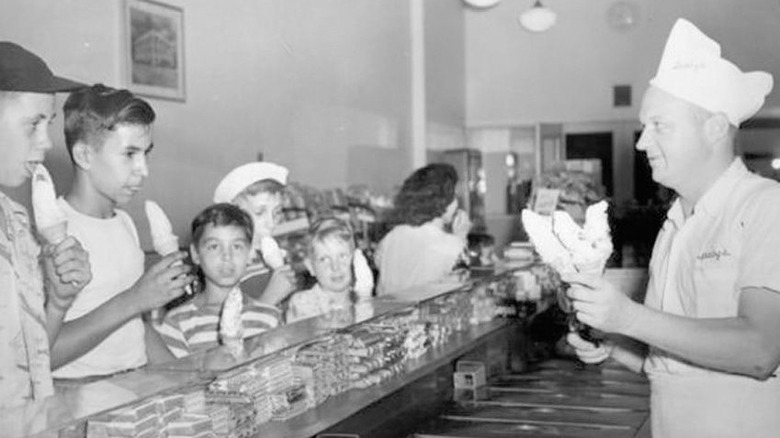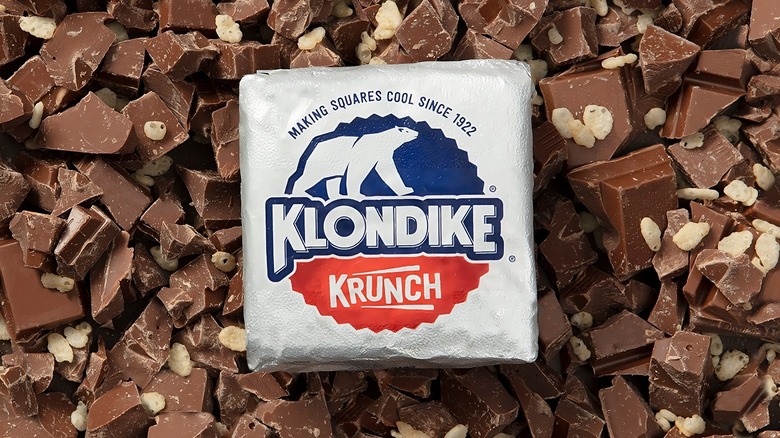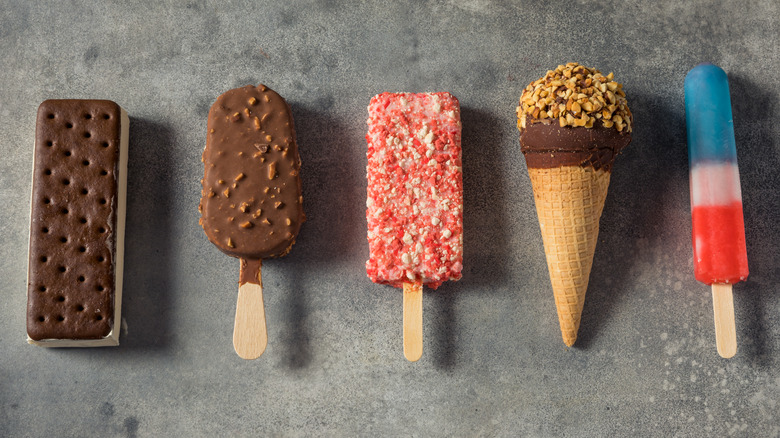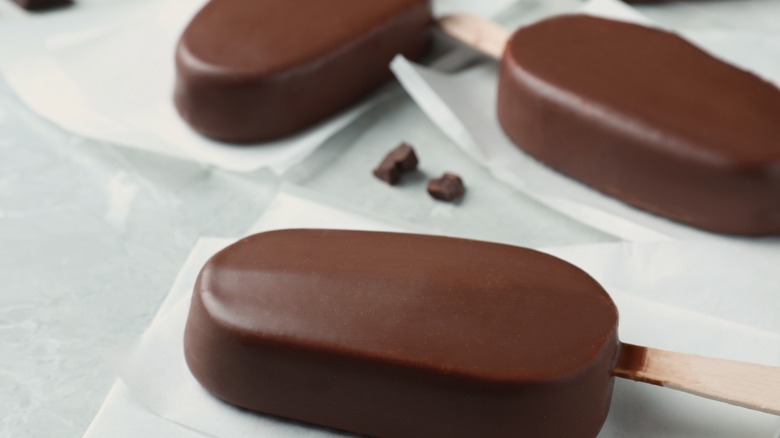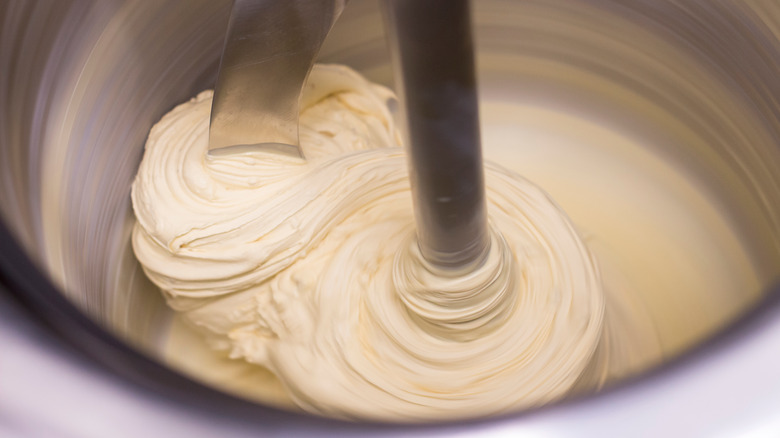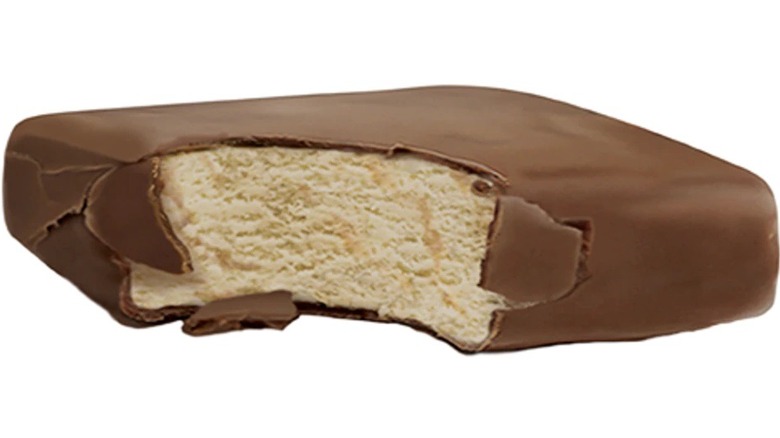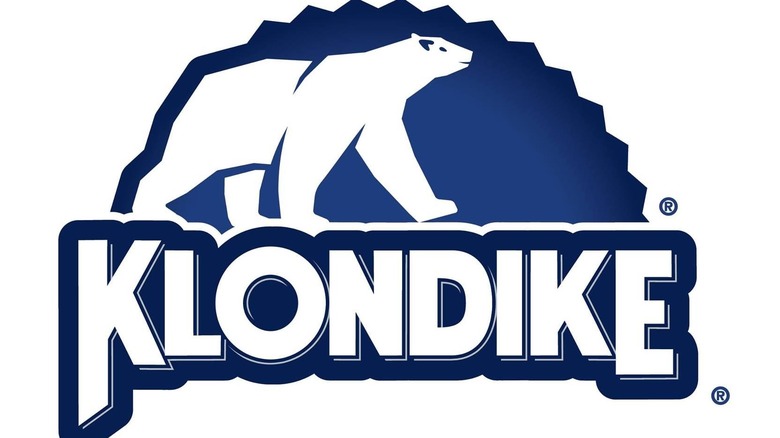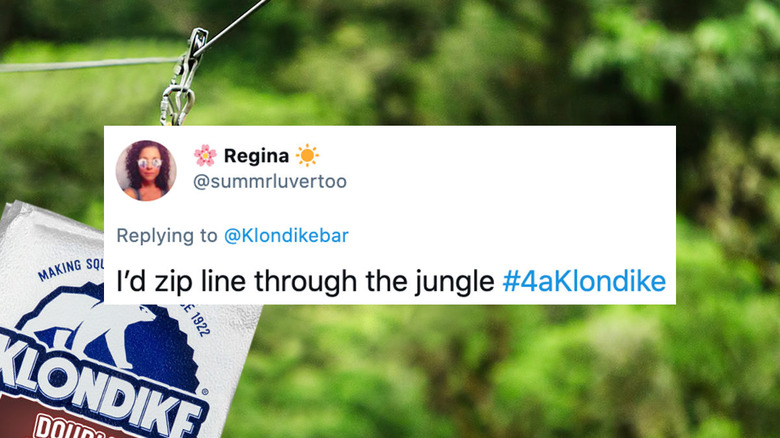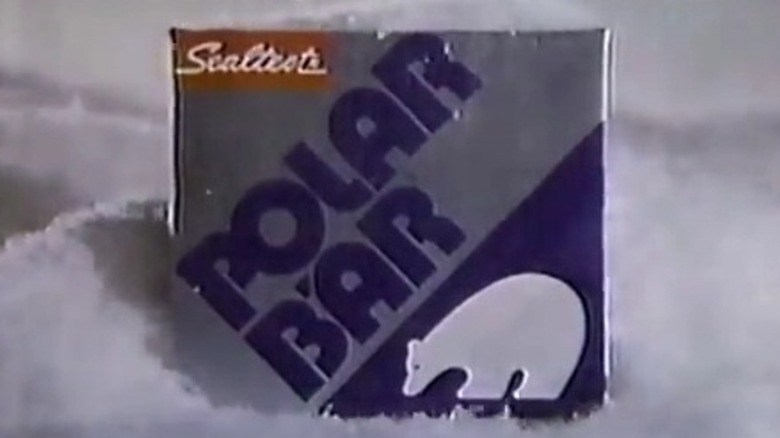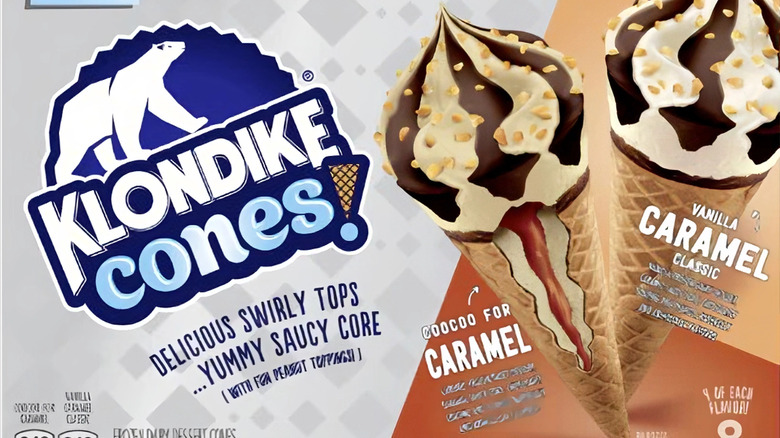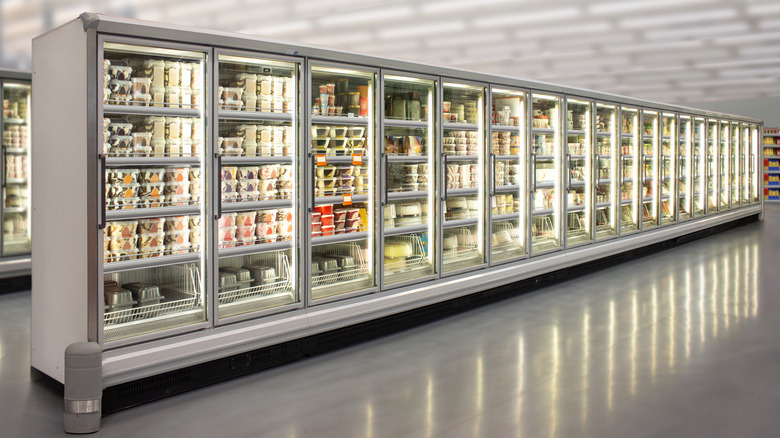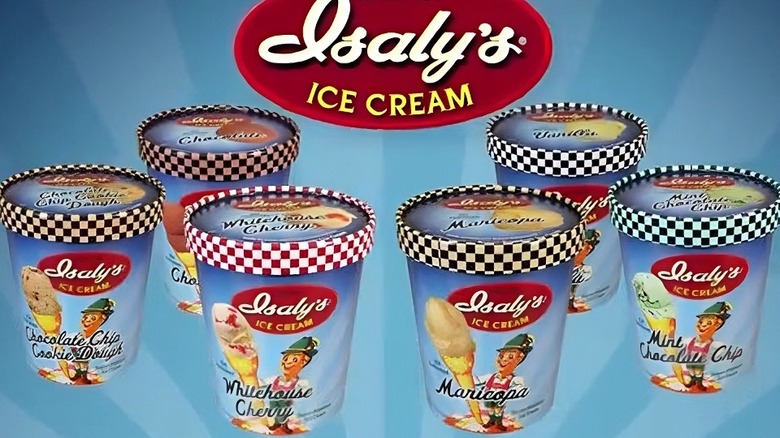The Illustrious History Of The Klondike Bar
In 2022, the Klondike bar marked its 100th year of satisfying people's desire for chocolate-coated ice cream. Now more than a century past its debut, this novelty frozen treat is going stronger than ever. According to Statista, 38.34 million Americans ate at least one Klondike bar in 2020, making it the most popular novelty treat in America. Reportedly, they produce about 380 million ice cream bars each year, with 98 million of them being the Original Vanilla flavor.
Even if you've never had a Klondike bar, there's a good chance you recognize the square shape, foil wrapper, and now-fabled slogan "What would you do for a Klondike bar?" — a slogan that Klondike of course built its 100th birthday celebration around. But we find the history of Klondike bars just as captivating as their looks. Did you know their famous motto wasn't introduced until 1982? Or that grape and maple were among the original flavors? Only you know what you would do for these Klondike bar facts, but we suggest reading on to learn more.
The Klondike bar was created by an Ohio dairy company
Like many food products that are now available across the country — or around the globe — the Klondike bar was originally local fare. The Isaly Dairy Company of Mansfield, Ohio was responsible for the first Klondike Bar. William Isaly originally founded the business in 1902 as the Mansfield Pure Milk Company, but its story goes back even further. Christian Isaly was a Swiss cheesemaker who emigrated to Ohio with his family in 1833. Over the generations, the Isalys expanded the cheese business into a full-blown dairy operation and even founded a regional retail store chain.
Soon after creating their milk company, the Isaly's bought out another plant in Youngstown, Ohio, and started serving five-cent ice cream cones there — which became a massive hit after they doubled the size of the treat. The Klondike bar was another product of the family's expansion. Its name was a reference to the Klondike River in Canada's Yukon province and the 1890s gold rush in one of its tributaries. Personally, we're glad they went with that and not the Yukon.
The bar was invented in 1922...we think
Although Klondike proclaims the Klondike bar was founded in 1922, we're actually not certain if this is true. "Klondikes, Chipped Ham & Skyscraper Cones," Brian Butko's 2001 book about the Isaly Dairy Company, doesn't give a founding date. Snack History proclaims Klondike bars were sold as early as 1920 while the Greenwich Daily Voice says they first appeared in the 1930s.
The best marker we have is the first known mention of the Klondike bar in print, which was on February 5, 1922. That day's Youngstown Vindicator newspaper featured an article talking about Chester Isaly giving the staff "several dozen" of the chocolate-coated bars. It also ran a Klondike bar advertisement referencing the new movie "Little Lord Fauntleroy" with Mary Pickford.
Interestingly, there were actually six "original" flavors. Bars with strawberry, chocolate, maple, cherry, and even grape ice cream initially joined vanilla in the lineup. Butko tells the York Daily Record these other flavors fell victim to standardization later in the decade. In 1922, you could get a Klondike bar for 10 cents — double what an Isaly's giant ice cream cone cost.
It was an early entry in the novelty ice cream fad
A popular movie wasn't the only thing the Klondike bar piggybacked on. Assuming the official founding date of 1922, the Klondike came out just one year after the Eskimo Pie. Declared "America's first chocolate-covered ice cream bar" by the Smithsonian Institution, the Eskimo Pie — now known as the Edy's Pie — debuted in 1921 and became a huge hit. The creators were granted a patent on January 24, 1922, for all candy-covered frozen treats — less than two weeks before the Klondike bar's first media mention. In one story, Chester Isaly admitted wanting to make something similar to the Eskimo Pie.
Many other variations soon hit the market. Harry Burt — another Youngstown, Ohio-based entrepreneur — developed the Good Humor Bar around the same time as the Eskimo Pie and Klondike bar. And in 1924, Frank W. Epperson established the Popsicle Corporation of the United States. This stampede of novelty ice cream treats combined with Prohibition helped boost U.S. ice cream sales by more than 40% during the 1920s. And any worries about violating Eskimo Pie's patent ended in 1929 when the U.S. Circuit Court of Appeals invalidated it over "lack of invention."
The Islay family disagrees about the Klondike bar's origin
Like many times when a creation gets big, multiple Isaly family members have taken credit for the Klondike bar. In addition to the story of Chester Isaly being inspired by the Eskimo Pie, Brian Butko details another version where Chester's brother Samuel discovered the recipe. This account was trumpeted for years in official press releases; however, it gives the founding year as 1929, seven years after the now-official version. In a third account, the Mansfield News Journal credits William Isaly with inventing the Klondike bar.
Who came up with the name is also disputed. Marian Isaly Schulz says her dad Charles Isaly suggested "Klondike." However, Robert Hinklin claims his dad Marion gave the name to Charles while working in the company's shipping department. Although it appears Marion Hinklin didn't start working for the Isaly's until 1924, he was on the same basketball team as Charles in 1922. There's even a rumor that Harry Burt of Good Humor fame collaborated with the Isalys. Ultimately, the question of exactly who invented and named the Klondike bar may never be answered.
Some early Klondike bars had sticks
One way the Klondike bar has stood out from other novelty treats is that there's no stick or cone — just an ice cream square. But this wasn't always the case. In the early years, the Isaly's plant in Youngstown, Ohio utilized the newest "ice cream on a stick" technology to make Klondike bars. As the most reliable machinery available, Klondikes on a stick were easier and cheaper to make.
So why did the sticks disappear? For that, we have Henry Isaly, the youngest Isaly brother of his generation, to thank. Henry considered the Klondike bar an "adult" ice cream treat and thought the sticks made it childlike. As such, he refused to let other Isaly's plants use sticks, instead coming up with a process where slices of ice cream were put on a hook and dipped in chocolate. Although it's unknown exactly when the stickless Klondike became the standard, this trait along with the foil wrapper has made it recognizable on store shelves.
New technology was created to make Klondike bars
With or without a stick, early production of every Klondike bar was done by hand. This all changed in 1931. Two years before, the Isaly's had targeted Pittsburgh as a place to expand beyond their Ohio roots. This included building a new plant in the city, and when it opened, it featured a machine known as the Polarmatic. Invented by an unknown member of the Isaly family, it automated the process of cutting ice cream squares and covering them in chocolate. One Polarmatic could make 75 Klondike bars a minute, and the plant could now churn out 11 million bars per year.
Klondike production has been moved into other factories over the years to keep up with demand, including a California factory that purportedly can make 1.2 million Klondikes per day. However, their publicist says the process is basically the same as it was with the original Polarmatic over 90 years ago, meaning generations of Klondike fans can thank a Depression-era machine.
Klondike bars have gotten cheaper over time
A common refrain is that things aren't as cheap as they used to be. In the case of the Klondike bar, this is true — it's actually cheaper when accounting for inflation. While writing in 2022 about Klondike's official 100th birthday, CNN Business noted the 10-cent cost of the bar in 1922. Calculating for inflation, this equates to a 2022 cost of $1.75.
Meanwhile, in the present day, a six-pack typically costs around $4. This comes out to 67 cents each. In other words, after inflation, a Klondike bar costs up to 62% less now than it did a century ago. Kevin Drum of Jabberwocking puts it another way: In 1922, the average American worker could buy 15,000 Klondike bars with their yearly salary. In 2022, the average salary was enough for 80,000 Klondike bars — more than five times as many. That's a lot of ice cream! So, if you're craving a Klondike bar, there's no need to feel guilty about the cost — it's a great deal.
Klondike was a regional treat for decades
It's easy to assume that Klondike bars quickly made their way into every grocery store ice cream freezer. But Klondike as a national brand is a relatively new phenomenon. According to the company itself, as late as the 1970s, you could only purchase them in Pennsylvania or Ohio. For more than half a century, the ice cream goodies were made and distributed by the Isaly's regional empire. Their retail stores were found throughout Ohio, greater Pittsburgh, and West Virginia with nearly 400 at the high point. Each location included a deli counter, restaurant, and ice cream section — strategically set up so people had to walk past the ice cream to get to the restaurant.
By association, Klondike also flourished during this time and is still strongly associated with Pittsburgh. But in the 1960s, Isaly's began to freefall. Many things factored into the decline, including the death of Henry Isaly in 1961 and the rise of both fast food and large supermarkets. Regardless, by the early 1970s, the Isaly business was on the brink — and the Klondike bar along with it.
Sales exploded under Henry Clarke
Luckily for Klondike fans, Henry DeBrunner Clarke Jr. was there to save the day, purchasing the brand from the Isaly's in 1976. Clarke was the owner of the Clabir investment firm and had no ice cream industry experience. But as a Pittsburgh native, he was certainly familiar with Klondike bars, and Clarke seized the opportunity to keep them alive. When Clarke bought Klondike, sales were roughly $800,000 a year — but under the new name of AmBRIT, those numbers soon soared. The ice cream became available in Florida in 1978 with New York and New England to follow. By the early 1980s, it was a national brand with annual sales reaching $60 million.
Unfortunately, Clarke's days with Klondike were numbered. Attempts to further diversify Clabir holdings brought financial difficulties which led to Clarke being forced to sell the Klondike brand. Clarke then entered the British ice cream market, consolidating Lyons Maid and several other smaller brands to compete directly with Haagen-Daz. But he told Brian Butko in 2001 that he still loved Klondike and would even straighten crooked boxes in store freezers.
Their fame was spurred by an iconic ad campaign
As part of their national rollout in 1982, Klondike debuted what would become a legendary modern advertising tagline: "What Would You do for a Klondike Bar?" Created by the MDC Partners ad agency, it was a way to see the lengths people would go to for their favorite ice cream snack. Early ads saw people acting like chickens and monkeys while modern acts have involved shaving eyebrows and literally jumping through hoops. As stated by Klondike, it's meant to be in the name of "spontaneous fun."
The campaign went on hiatus in 2012, seemingly putting an end to the challenges. However, in 2019, Klondike brought the tagline back with two commercial spots — including one offering couples a lifetime's worth of Klondike bars in exchange for letting someone else name their baby. More than 40 years after its introduction, the eight-word question continues to resonate. In 2023, a survey by Quality Logo Products rated the Klondike ad jingle as the 17th-most recognizable, beating out melodies by Ace Hardware and Liberty Mutual among others.
Kraft tried to rip off Klondike bars
When a regional brand takes on the Goliaths of the dessert aisle, the Goliaths are bound to notice. In the case of Klondike and Kraft, it started amicably enough, with Kraft signing an agreement to distribute Klondike bars in Florida. But almost immediately, Kraft started pressuring AmBRIT to either sell the bar to them outright or let them repackage it under their Sealtest brand.
AmBRIT said no on both counts — and Kraft responded with a vengeance. Via a previous merger with Southern Dairies, Kraft owned the trademark to "Polar B'ar", an ice cream product sold from 1929-32. In late 1979, they began developing an ice cream bar to rival Klondike. The result was suspiciously similar to the Klondike bar in every way: Ice cream covered in chocolate, a square shape, a silver foil wrapper, and even a polar bear logo. Finally, in February 1982, Kraft told AmBRIT they were terminating the Klondike distribution agreement to sell their copycat version.
Klondike vs. Kraft ended up in court
Not surprisingly, AmBRIT didn't appreciate this obvious and direct threat. In May 1982, they filed a federal lawsuit against Kraft. Among other things, AmBRIT accused Kraft of infringing on its Klondike trademark, unfair competition practices, and violating the Lanham Act.
On December 10, 1986, the U.S. Court of Appeals, 11th Circuit ruled in favor of AmBRIT. The decision ordered Kraft to change its packaging to avoid confusion with Klondike bars and for a federal judge to decide on any monetary damages. They even granted AmBRIT's request to cancel Kraft's Polar B'ar trademark, agreeing that since the name went unused for nearly 50 years, it was considered abandoned under U.S. law.
Kraft tried to salvage a victory, appealing the decision to the U.S. Supreme Court. But in May 1987, the Supreme Court refused to hear the case. Finally, in February 1988, the Chicago Tribune reported that Kraft had changed the Polar B'ar packaging the previous year and would pay AmBRIT $8.5 million to settle the lawsuit.
There's more to Klondike than just ice cream bars
Although the vanilla ice cream square with a chocolate coating is the most famous Klondike offering, it's far from the only one. Did you know that Klondike created the Choco Taco? It was their first non-square treat in 1984 and might have been even more adored by its fans than the Klondike bar. Sadly, Klondike discontinued the Choco Taco in 2022, though they left the door open for a possible return.
In recent years, Klondike has also introduced sundae cones, to-go shakes, mini ice cream bars, and ice cream sandwiches. Even the basic bar has seen an ever-evolving selection. Klondike currently lists 10 bars on their website, including bars with Heath, Reese's, cookies and cream, and mint chocolate chip ice cream. They've also created no-sugar-added versions of the vanilla and Krunch bars. Past ice cream flavors have reportedly included rocky road and caramel. If you have another flavor in mind, Klondike has admitted they listen to ideas on social media.
People have tried to steal Klondike bars many times
While their ubiquitous slogan is meant to be in good fun, the desire for a Klondike bar has taken a darker turn. For example, in 2009, UPI reported a Florida man tried to swipe a Klondike bar from a convenience store. When he was caught, he offered $69 for the bar — which cost $1.29 at retail. The offer was rejected and the man was arrested. The same year, two Pennsylvania teens burglarized a house and stole a box of Klondike bars along with cash and a cell phone (via Trib Total Media). The homeowner eventually got everything back — including the ice cream.
Finally, in 2008, LancasterOnline detailed the story of a serial thief busted attempting to plunder two packs of Klondike bars in a duffel bag. Those are just three of the times people have resorted to thievery in the name of ice cream square. No wonder there's now a cottage industry of merchandise built around the phrase, "I'm ashamed of what I did for a Klondike bar."
Unilever purchased Klondike in 1993
Although their relationship with Kraft ended acrimoniously, Klondike eventually became part of another food conglomerate. On February 2, 1993, it was announced that the Thomas J. Lipton Corp. — a subsidiary of Unilever — had purchased what was now The Isaly Klondike Co. Having become part of Empire of Carolina Inc. after Henry Clarke's ouster and now based in Clearwater, Florida, the Tampa Bay Times said it cost $155 million for Unilever to acquire the brand.
As part of the deal, The Isaly Klondike Co. was renamed Klondike Ice Cream Inc. and folded into the Good Humor-Breyers division — extremely fitting when you remember the Youngstown, Ohio roots of both Klondike and Good Humor. Even more fascinating is that, at the same time they bought Klondike, Lipton also acquired Popsicle Industries Ltd. of Canada, putting three famous frozen treats under one roof. In late 2022, though, Reuters reported Unilever was considering selling Klondike and some other ice cream brands, though nothing further has been announced as of this writing.
Isaly's is still around
There is a heartwarming epilogue to the Klondike story: Although the Isaly family is no longer active, the name and legacy have been kept alive. After the last of the Isaly family retired in the 1980s, the Deily family — longtime Isaly friends and suppliers — took over operations. For three decades, the Deilys ran the brand, which especially continued to thrive in Pittsburgh. In 2015, fellow regional food business Conroy Foods, Inc. bought the brand.
Today, Islay's is primarily known for deli products distributed to supermarkets throughout the Midwest and Mid-Atlantic. This includes the chipped-chopped ham that may once have been their most famous product. A few branded restaurants are still left, too, including one in Pittsburgh on Perry Highway. And selling off the Klondike bar didn't mean the end of their ice cream ventures. The Conroys found the company's original ice cream recipes in a box of memorabilia, and since 2017, they've been making old-fashioned pints for a new generation.

